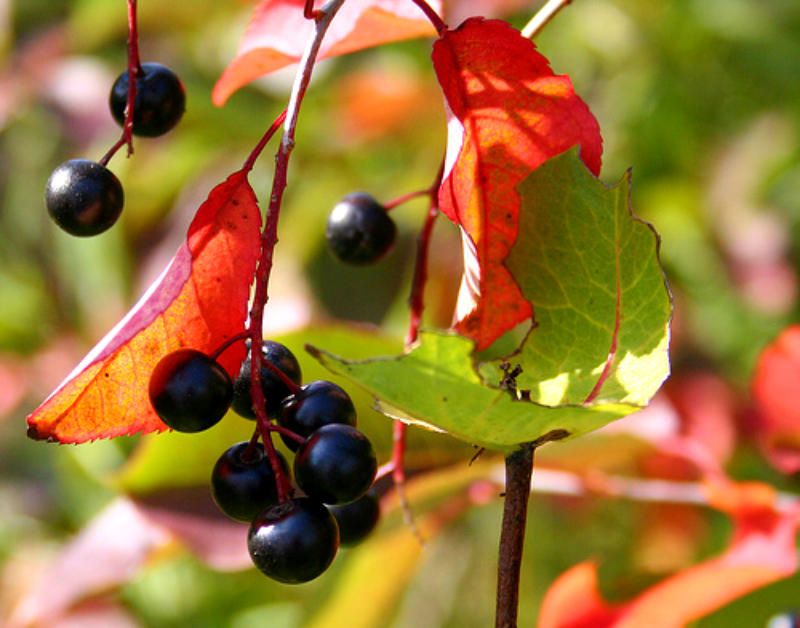TasunkaWitko
Well-Known Member
Along with Bruxelles Blonde, another one of my upcoming brews from Brooklyn Brew Shop is Cherry Hill Wheat:
http://brooklynbrewshop.com/beer-making-mixes/cherry-hill-wheat-mix
For reference, here are the brewing instructions for this 1-gallon, all-grain mix:
http://brooklynbrewshop.com/directions/Brooklyn_Brew_Shop_Cherry_Hill_Wheat_Instructions.pdf
My original plan had been to make this with Flathead Cherries grown here in Montana, but unfortunately the crop that we got this year wasn't the best, so none of those cherries ever made it to me.
I was just about to go to the store and simply pick up a bag of cherries to use; however, while picking chokecherries with my son for syrup and wine, it occurred to me that these might work well with a wheat beer. Beyond that, the marriage of chokecherry and a wheat beer would very nicely reflect my North Dakotan and Montanan heritage.

With that, I decided to give it a try.
Those of you know have experience with chokecherries know that the extracted juice makes wonderful syrup with a unique flavor, quite different from the astringent quality that chokecherries have when eaten "straight off the tree." Taking that into account, I think that this is an experiment worth trying, but I had a couple of questions:
The instructions (referenced above) advise adding 1 cup of pitted "regular" cherries and adding them with 5 minutes left in the boil; however, those with experience know that pitting chokecherries is kind of like herding cats - it just can't really be done. With that in mind, I'm thinking I should probably add a few extra (to make up for the large pits) and boil them a bit longer (to make up for the time needed to extract the juice and flavor).
Currently, I am thinking to double the amount of chokecherries (to two cups), and adding them in with 30 minutes left in the boil, since when I am making syrup, I boil them for 30 minutes anyway. I am also planning to gently mash the chokecherries as I would normally when rendering them for syrup.
Before I do this, however, Id like to solicit opinions and advice from anyone with experience working with chokecherries, in the hops that you could share your experience or ideas. Do my proposed alterations make sense, or should I simply add 1 cup of chokecherries with 5 minutes left in the boil?
Please advise, and thanks in advance -
Ron
http://brooklynbrewshop.com/beer-making-mixes/cherry-hill-wheat-mix
For reference, here are the brewing instructions for this 1-gallon, all-grain mix:
http://brooklynbrewshop.com/directions/Brooklyn_Brew_Shop_Cherry_Hill_Wheat_Instructions.pdf
My original plan had been to make this with Flathead Cherries grown here in Montana, but unfortunately the crop that we got this year wasn't the best, so none of those cherries ever made it to me.
I was just about to go to the store and simply pick up a bag of cherries to use; however, while picking chokecherries with my son for syrup and wine, it occurred to me that these might work well with a wheat beer. Beyond that, the marriage of chokecherry and a wheat beer would very nicely reflect my North Dakotan and Montanan heritage.

With that, I decided to give it a try.
Those of you know have experience with chokecherries know that the extracted juice makes wonderful syrup with a unique flavor, quite different from the astringent quality that chokecherries have when eaten "straight off the tree." Taking that into account, I think that this is an experiment worth trying, but I had a couple of questions:
The instructions (referenced above) advise adding 1 cup of pitted "regular" cherries and adding them with 5 minutes left in the boil; however, those with experience know that pitting chokecherries is kind of like herding cats - it just can't really be done. With that in mind, I'm thinking I should probably add a few extra (to make up for the large pits) and boil them a bit longer (to make up for the time needed to extract the juice and flavor).
Currently, I am thinking to double the amount of chokecherries (to two cups), and adding them in with 30 minutes left in the boil, since when I am making syrup, I boil them for 30 minutes anyway. I am also planning to gently mash the chokecherries as I would normally when rendering them for syrup.
Before I do this, however, Id like to solicit opinions and advice from anyone with experience working with chokecherries, in the hops that you could share your experience or ideas. Do my proposed alterations make sense, or should I simply add 1 cup of chokecherries with 5 minutes left in the boil?
Please advise, and thanks in advance -
Ron



















































![Craft A Brew - Safale BE-256 Yeast - Fermentis - Belgian Ale Dry Yeast - For Belgian & Strong Ales - Ingredients for Home Brewing - Beer Making Supplies - [3 Pack]](https://m.media-amazon.com/images/I/51bcKEwQmWL._SL500_.jpg)







